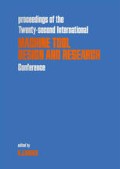Summary
On the basis of previous works, general problems of optimizing metal cutting process are further discussed. The prerequisite for the optimum control of the metal cutting process is to seek out the dynamic characteristics of both the machine tool and the metal cutting process which are most conformable to reality. Experiments aimed at identifying metal cutting process in lathe with their results are presented. In experiments, cutting depth and width simulating impulse signal are used. By means of the system approach and the techniques of DFT and FFT and by making use of the curve fitting method, dynamic characteristics of both the machine tool and the cutting process are obtained, empirical formulas for dynamical cutting force are presented. On the basis of which, prospects of optimization of the metal cutting process are discussed. Scheme of a compensating device for the purpose of attainment of the best surface finish and geometrical accuracy of the workpiece are presented and simulated on an analog computer.
Postgraduate student.
Professor, Head of Division, Division of Hydraulic and Mechanical Control Engineering, Department af Mechanical Engineering.
Preview
Unable to display preview. Download preview PDF.
References
“Identification and Optimum Control of Metal Cutting Process.” H.H.Yang, G.P.Yang and K.N.Chen, Proceedings of 21st Int.M.T.D.R. Conf., Swansea, U.K.
“An Investigation on Optimum Control of Metal Cutting Processes Based on Modern Control Theory.” G.P.Yang, Q.X. Zhang and H.H.Yang, to be published in IXNorth American Manufacturing Research Conference.
“Engineering Cybernetics.” by H.S. Tsien, (McGraw-Iiill Publishing Company Ltd., 1954)
“System Identification for Self-Adaptive Control”, by W.D.T.Davies, (John Wiley & Sons Ltd., 1970)
“Mechanical Control Engineering”, Text-book in Chinese, Division of Hydraulic and Mechanical Control Engineering, Dept. of Mechanical Engineering, Xian Jiactonur University, 1980).
“Analysis of the Dynamic Characteristics of Manufacturing Process and Equipments”, in Chinese, by H.H.Yang, Xian Jiaotong University, 1972.
“System Identification of the machinning Process”, D.A. Milner, Trans. ASME, Journal of Engneering for Industry, August, 1975.
“Analysis of Chatter Vibration Through Step-Function Response”, H.Takeyama and C. Sakata, Trans. ASME, series B, Nov., 1972.
Author information
Authors and Affiliations
Editor information
Editors and Affiliations
Copyright information
© 1982 Macmillan Publishers Limited
About this chapter
Cite this chapter
Yang, G.P., Wang, X., Zhang, Q.X., Yang, H.H. (1982). An Investigation on Metal Cutting Dynamics and Its Optimum Control Based on Modern Control Theory. In: Davies, B.J. (eds) Proceedings of the Twenty-second International Machine Tool Design and Research Conference. Palgrave, London. https://doi.org/10.1007/978-1-349-06281-2_36
Download citation
DOI: https://doi.org/10.1007/978-1-349-06281-2_36
Publisher Name: Palgrave, London
Print ISBN: 978-1-349-06283-6
Online ISBN: 978-1-349-06281-2
eBook Packages: EngineeringEngineering (R0)

